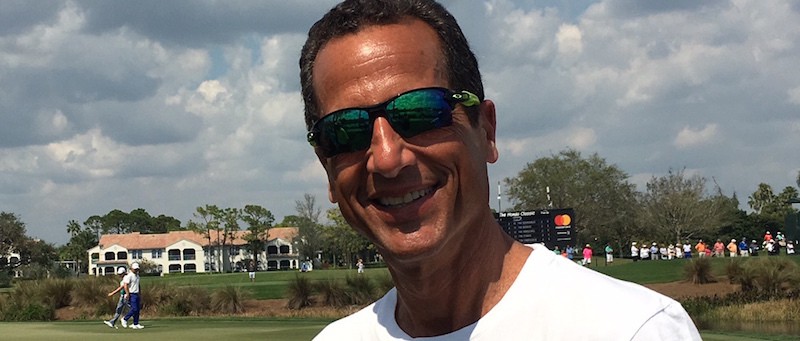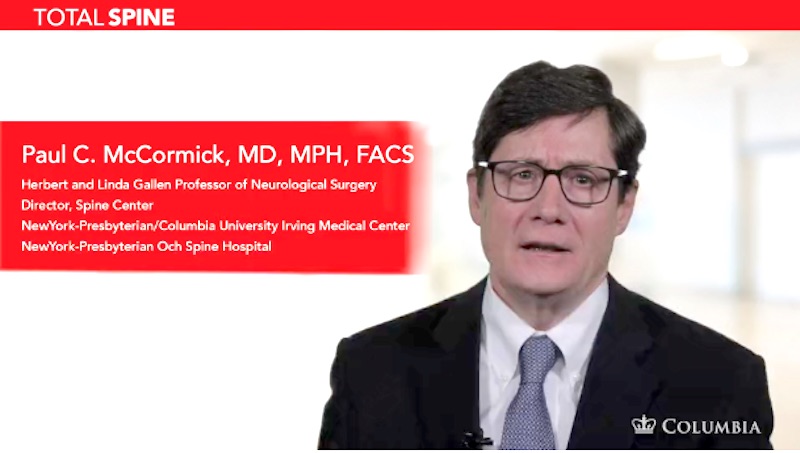 “You can’t always trust what you read online,” says Pete Mandelkern. That said, he really wants people to listen to him about back surgery. “Dr. McCormick changed my life,” he says.
“You can’t always trust what you read online,” says Pete Mandelkern. That said, he really wants people to listen to him about back surgery. “Dr. McCormick changed my life,” he says.
Before he saw Dr. Paul McCormick, Director of the Spine Hospital at the Neurological Institute of New York, Pete went to the Hospital website and read testimonials. “I never know whether to believe them,” he says. But now Pete wishes he could make people understand that what he has to say is real.
Dr. McCormick was not the first doctor Pete saw in trying to address his chronic back pain. He was the last—and the one who finally provided relief. The lumbar fusion Dr. McCormick performed cured Pete of pain that had caused him to see a succession of doctors and even undergo ineffective surgery.
When Pete got to Columbia, he had been coping with lower back trouble for 20 years. For most of that time, he had managed with a combination of injected medication and physical therapy, and he had continued to work and exercise.
Unfortunately, the pain got worse. It began to radiate into his right leg, and the short-term fixes he’d been relying on were no longer effective.
“I couldn’t stand,” he recalls. “I couldn’t walk more than a minute at a time. I could alleviate the pain when I sat down—that would take the pressure off the nerve. But any time I was on my feet, I had a sharp pain running down my right leg.”
The pain altered his lifestyle and his mood. “It was psychologically debilitating,” he recalls. In the summer of 2014, he consulted an orthopedic surgeon and discovered he would need an operation.
In January 2015, Pete underwent procedures aimed at reopening the passageways for nerves in his lower back. To his dismay, his condition continued to deteriorate after surgery, and the pain increased.
When a friend suggested Pete meet with Dr. McCormick, he was surprised. Until then, he had not realized a neurosurgeon might be the right kind of doctor for him. In August 2015, Pete and Dr. McCormick sat down to discuss Pete’s history and look at images of his spine.
Dr. McCormick noted Pete’s spinal stenosis, a narrowing of the tunnel running through his spine. The nerves inside, like cables in a shrinking pipe, were getting squeezed. Dr. McCormick also observed degenerative disc disease and a reduction in the space available for certain nerves to exit the spine—a condition known as foraminal narrowing.
The stenosis and narrowing were likely culprits in the painful pressure on the nerves in Pete’s leg. Dr. McCormick ordered additional images of Pete’s spine, and the two planned to meet again to discuss the possibility of surgery.
“Dr. McCormick had an excellent bedside manner. He spoke directly and to the point,” Pete recalls. Just hearing Dr. McCormick say he thought he could help made Pete feel better. “I was starting to think I was going to have to live with this for the rest of my life.”
Dr. McCormick is passionate about helping with situations like Pete’s. He says he often meets people whose daily lives have been dramatically altered by their conditions, and they are miserable.
Pete’s chronic pain wore on him. “I’m young,” he says. “I’m very active, and I exercise a lot. The pain stopped me from doing any of that. I took being active for granted until I lived without it. I needed to get back to that lifestyle.”
Pete had what Dr. McCormick calls a “quality-of-life-threatening condition.” What motivates Dr. McCormick is the potential to restore each patient’s quality of life. He says seeing a patient’s joy after a successful operation is the most rewarding aspect of his work.
Dr. McCormick decided the best option for Pete would be fusion surgery to stabilize his spine. Dr. McCormick would gently remove the bone and scar tissue that were pinching Pete’s nerves and putting his spine in peril.
He would construct a bridge of screws and rods to connect the vertebrae surrounding the weakened area. And he would graft some of Pete’s bone into the site for additional stability. They set a date in November 2015.
Pete’s surgery lasted six hours, and he was up walking the next day. He stayed in the hospital for just five days, and during that time he worked with physical therapists who taught him how to move around—before he believed he could. Pete calls the therapists “very professional,” and he felt that the whole Columbia Presbyterian team acted as if they couldn’t do enough for him.
While Pete was in the hospital, he was sore around the surgical incision, but there was no pain in his leg. Three weeks later, he was back at work and focused on strengthening his core muscles with a physical therapist.
Two years later, Pete feels great. He has been pain-free since the spinal fusion surgery, and these days you can find him on the golf course, at the gym or working in his garden. “I can do whatever I want to do,” he says. “I’m very thankful.”


